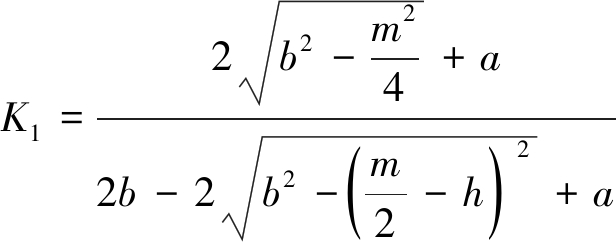
移动阅读
郭广礼1,2,李怀展1,2,查剑锋1,2,刘潇鹏1,2,徐友友1,2
(1.中国矿业大学 江苏省资源环境信息工程重点实验室,江苏 徐州 221116; 2.中国矿业大学 环境与测绘学院,江苏 徐州 221116)
摘 要:煤炭地下气化是我国先进能源领域重要的研究方向之一,也是我国煤炭资源“流态化”开采技术体系的重要组成部分。目前已完成的煤炭地下气化工业性实验由于实验规模较小没有引起显著的裂隙发育和明显的地表沉降发生。但随着煤炭地下气化实验规模的扩大及推广应用,如何面向不同地质条件进行地下气化生产设计控制裂隙发育及地表沉降是目前亟待解决的瓶颈问题,极大的限制了煤炭地下气化的选址及规模化生产。为了解决这个难题,利用数值模拟方法研究了无井式煤炭地下气化岩层与地表移动规律以及导水裂隙发育高度与气化炉参数的关系,同时利用理论方法提出了“双曲线”型焦化隔离煤柱稳定性评价方法。研究得出:① 无井式煤炭地下气化岩层和地表移动曲线与常规条带开采岩层和地表移动曲线形态相似,可参考条带开采地表沉陷预测方法进行无井式煤炭地下气化岩层和地表沉陷计算,但预测参数需修正;② “双曲线”型煤柱评价可分为弯曲和矩形两部分进行,并在此基础上建立了“双曲线”型煤柱稳定性评价方法,可为不同地质条件下地下气化生产设计提供技术支撑;③ 无井式煤炭地下气化引起的导水裂隙发育高度与气化炉参数直接相关。当气化炉高度一定且隔离煤柱稳定时,气化炉宽度与导水裂隙发育高度呈线性正相关;当气化炉宽度和隔离煤柱宽度一定时,气化炉高度与导水裂隙发育高度也呈线性正相关,故在覆岩含水层下进行地下气化生产时,要兼顾导水裂隙与气化炉参数的关系。
关键词:煤炭地下气化;气化炉宽度;“双曲线”型煤柱;导水裂隙发育高度
郭广礼,李怀展,查剑锋,等.无井式煤炭地下气化岩层及地表移动与控制[J].煤炭学报,2019,44(8):2539-2546.doi:10.13225/j.cnki.jccs.KJ19.0531
GUO Guangli,LI Huaizhan,ZHA Jianfeng,et al.Movement and control of strata and surface during UCG without shaft[J].Journal of China Coal Society,2019,44(8):2539-2546.doi:10.13225/j.cnki.jccs.KJ19.0531
中图分类号:TD844
文献标志码:A
文章编号:0253-9993(2019)08-2539-08
收稿日期:2019-04-28
修回日期:2019-05-27
责任编辑:常明然
基金项目:国家自然科学基金青年基金资助项目(51804301);江苏省自然科学基金青年基金资助项目(BK20180661);国家自然科学基金面上资助项目(51674249)
作者简介:郭广礼(1965—),男,河北栾城人,博士生导师。E-mail:guangliguo@cumt.edu.cn
通讯作者:李怀展(1990—),男,河南济源人,讲师。E-mail:lihuaizhan@cumt.edu.cn
GUO Guangli1,2,LI Huaizhan1,2,ZHA Jianfeng1,2,LIU Xiaopeng1,2,XU Youyou1,2
(1.Jiangsu Key Laboratory of Resources and Environment Information Engineering,China University of Mining and Technology,Xuzhou221116,China;2.School of Environment Science and Spatial Informatics,China University of Mining and Technology,Xuzhou221116,China)
Abstract:Underground coal gasification (UCG) is one of the important research directions in advanced energy field,and is also an important part of the fluidized mining technical system of coal resources.At present,the completed small-scale UCG industrial experiments haven’t caused significant fractures and surface subsidence.However,with the application and large-scale production of UCG,how to carry out UCG production design for controlling fracture development and surface subsidence under different geological conditions is the bottleneck problem that greatly hinders the site selection and large-scale production of UCG and urgently needs to be solved.To overcome the problem,the numerical simulation method was adopted in this paper to study the strata and surface movement characteristic of UCG without shaft and the relationships between development height of water flowing fractures and gasifier parameters.At the same time,the stability evaluation method of hyperbolic coking coal pillar was proposed by the theoretical method.The results indicate that:① The curve shapes of strata and surface movement under UCG without shaft are similar with those under conventional strip mining.Therefore,the strata and surface subsidence calculation of UCG without shaft can refer to that in strip mining,but the prediction parameters need to be revised.② The stability evaluation of hyperbolic coal pillar can be divided into bending part and rectangular part.On which basis,the stability evaluation method of hyperbolic coal pillar was proposed,which could provide a technical support for UCG design and production under various geological conditions.③ The development height of water flowing fractures due to UCG without shaft is directly related with the gasifier parameters.When the gasifier height has a certain value and the isolated coal pillars are stable,the gasifier width has a linear positive correlation with the development height of water flowing fracture.When the gasifier and the isolated coal pillar has certain width,a linear positive correlation also exists in the gasifier height and the development height of water flowing fracture.Therefore,the implementation of UCG under overburden aquifer needs to consider the relationships between the development height of water flowing fracture and gasifier parameters.The research results could provide a scientific basis for large-scale UCG production and site selection.
Key words:underground coal gasification;gasifier width;hyperbolic coal pillars;development height of water flowing fracture
煤炭地下气化(简称UCG)是煤炭资源“流态化”开采技术体系的重要组成部分,也是煤炭行业未来发展的重要技术方向之一。煤炭地下气化是通过煤的热作用及化学作用提取煤中含能成分,而将灰渣等废弃物留在地下,真正意义上实现煤炭的绿色开采[1-6]。
自1868年德国科学家WILLIAM首次提出煤炭地下气化概念[7],后经过国内外学者150余年努力,主要形成了5种气化工艺(图1),并在全球至少40个地方进行了工业性实验[8]。总的来说,现有的煤炭地下气化工艺可基本满足规模化生产需求。

图1 煤炭地下气化发展历程
Fig.1 UCG development history
已完成的工业性试验[9-11]大多选择地质条件相对较简单区域,实验区规模小、气化面间隔离煤柱相对较大,试验中较好地保证了地下气化的安全进行,也没有引起显著的裂隙发育及明显的地表沉降发生。但是随着地下气化实验规模的扩大和推广应用以及必须顾及的资源采出率问题,如何面向不同地质条件进行地下气化生产设计控制裂隙发育及地表沉降是目前亟待解决的瓶颈问题,极大的限制了煤炭地下气化的规模化及产业化生产。基于此,笔者拟在研究无井式煤炭地下气化岩层和地表移动规律的基础上,提出“双曲线”型焦化隔离煤柱稳定性评价方法,揭示气化炉参数对导水裂隙发育高度的影响。研究成果可为无井式煤炭地下气化选址提供科学依据和技术支撑。
立足乌兰察布气化场19号钻孔柱状图建立了煤炭地下气化初始模型,气化煤层为近水平煤层、厚度为5 m,具体的岩层及高度见表1。考虑到无井式地下气化燃空区的形态呈“环形跑道”状[12],故采用ANSYS软件建立初始模型,并导入FLAC3D计算。模型中各岩层本构模型采用摩尔库伦模型。初始模型中气化前岩层力学参数依据室内实测的力学参数确定[13],具体的岩石力学参数见表1。模型底部边界取u=v=w=0(u为x方向位移,v为y方向位移,w为z方向位移)全约束边界,顶部为自由边界,左右边界为水平位移约束边界。初始模型长600 m、宽600 m、高293 m,网格平面尺寸为4 m×4 m,高度随岩层高度略有不同,共划分382 940个单元,639 941个节点。
表1 柱状图及气化前模型力学参数
Table 1 Drill column and initial model parameters before gasification

考虑到原煤和覆岩受高温的影响,其力学性质会发生显著变化。为了模拟气化后岩层及地表移动规律,模型中考虑了原煤和覆岩受高温影响的范围及力学性质变化规律[14]。气化后模型中顶底板岩层力学参数具体见表2。
为了验证建立模型的可靠性,根据模拟结果作了煤炭地下气化地表沉陷模拟图,如图2所示。由图2可知,模拟结果得到此次工业性实验地表下沉最大值为42.4 mm。考虑到距离最大下沉点约10 m的CG05监测点的地表下沉值为36 mm,可判断出模型模拟结果基本符合实际情况,建立的数值模型可靠。
表2 煤炭地下气化后顶底板岩层力学参数
Table 2 Roof and floor strata mechanics parameters after gasification


图2 乌兰察布矿煤炭地下气化地表沉陷模拟结果
Fig.2 Surface subsidence simulation results in UCG of Ulanqab coal mine
利用建立的模型,模拟研究了无井式煤炭地下气化后岩层和地表移动最终规律。根据模拟结果作无井式地下气化和条带开采主断面顶板岩层和地表下沉曲线,如图3所示。分析图3可知,无井式煤炭地下气化顶板岩层和地表下沉曲线与常规条带开采的顶板和地表下沉曲线形态非常相似,从顶板岩层的波浪式下沉分布向上逐渐过渡到地表的单一下沉盆地,煤炭地下气化岩层和地表移动规律与常规条带开采下沉规律基本相似;两者差异的主要原因是由于气化炉形态以及围岩和隔离煤柱高温效应的影响。因此,可参考条带开采方法进行无井式煤炭地下气化岩层移动和地表沉陷计算与控制,但具体的计算方法及参数需进一步研究[15]。

图3 无井式煤炭地下气化和条带开采岩层及 地表下沉曲线对比
Fig.3 Comparison of UCG without shaft and strip mining on strata and surface subsidence curves
结合无井式煤炭地下气化的工艺特点和现场实测揭示,无井式煤炭地下气化燃空区的气化截面近似为扁椭圆形,呈“环形跑道”状;整体呈高度为煤厚的长条状、扁椭圆型空间体,如图4所示。

图4 无井式煤炭地下气化燃空区形态
Fig.4 Physical structure of combustion in UCG without shaft
因此,“双曲线”型煤柱稳定性评价可分为弯曲和矩形两部分进行,如图5所示。当煤柱承受的实际载荷小于“双曲线”型煤柱弯曲部分所能承受的载荷时,“双曲线”煤柱稳定;当煤柱承受的实际载荷大于“双曲线”型煤柱弯曲部分所能承受在载荷时,要保证“双曲线”煤柱稳定,“双曲线”型煤柱矩形部分所能承受的载荷应该大于煤柱实际承受的载荷。

图5 “双曲线”型煤柱示意
Fig.5 Schematic diagram of a hyperbolic coal pillar
2.2.1弯曲部分煤柱稳定性评价
由图5可知,“双曲线”型煤柱弯曲部分结构不稳定,在上覆载荷的作用下,部分弯曲煤柱会发生剪切破坏。假定当弯曲部分煤柱高度为h时,在某一微小的单元内,弯曲煤柱刚好能承受上覆荷载:
![]()
(1)
其中:
![]()
(2)
τxz=σxtanφ+c
(3)
σx=λσz
(4)

(5)
式中,h为弯曲部分煤柱高度,m;H为煤层深度,m;b为燃空区宽度,m;m为煤层采厚,m;σz为煤柱上垂直应力,MPa;σx为煤柱侧压力,MPa;τxz为煤柱弯曲部分刚好能承受上覆荷载时的剪应力,MPa;λ为煤层侧压力系数,λ=ν/(1-ν),ν为地下气化后隔离煤柱弯曲部分的泊松比;c为气化后隔离煤柱弯曲部分平均黏聚力,MPa;a为隔离煤柱宽度,m;γ为上覆岩层的平均容重,MN/m3;K1为应力集中系数;φ为气化后隔离煤柱弯曲部分平均内摩擦角,(°)。
联立式(1)~(5)得

(6)
通过迭代的方法可求得h。当h<m/2时,说明“双曲线”型隔离煤柱弯曲部分稳定,即“双曲线”型煤柱稳定。当h>m/2时,说明“双曲线”型隔离煤柱弯曲部分不稳定,此时需进一步评价“双曲线”型隔离煤柱的矩型部分。
2.2.2矩型部分煤柱稳定性评价
当“双曲线”型煤柱弯曲部分失稳时,煤柱的受力情况如图6所示。“双曲线”型煤柱矩形部分承担上覆荷载,“双曲线”型煤柱实际承受的载荷σp2为
![]()
(7)
式中,δ为燃空区上覆岩层垮落角,(°);L为煤柱长度,m。

图6 “双曲线”型煤柱弯曲部分失稳时实际载荷
Fig.6 Actual load for unstable bending zone of a hyperbolic coal pillar
“双曲线”煤柱中矩形部分煤柱所能承受的极限载荷[16]为
(a-0.004 92mH)L
(8)
式中,c1,φ1为气化后矩形部分煤柱的平均黏聚力和内摩擦角。
为了保证“双曲线”型煤柱矩形部分有足够的强度,必须满足:
![]()
(9)
根据工程需要取适当的K值,即可对“双曲线”型煤柱稳定性进行评价。特此说明本文提出的方法是评价“双曲线”型煤柱的最终稳定与否。
地下气化引起的导水裂隙发育高度直接关系到地下气化的安全进行及污染控制。因此,导水裂隙发育高度是进行煤炭地下气化选址的重要指标之一。本节主要采用数值模拟方法研究气化炉参数与导水裂隙发育高度的关系。
地下气化引起的导水裂隙发育高度与气化炉高度、气化炉厚度及隔离煤柱宽度等气化炉参数有关。为了研究导水裂隙发育高度与气化炉参数的关系,设计了模拟方案,见表3。
表3 导水裂隙发育高度与气化炉参数关系模拟方案设计
Table 3 Simulation scheme design for water flowing fracture height and gasifier parameter

为了分析导水裂隙发育高度与气化炉参数的关系,根据表3中设计方案,建立了17个数值模型。同时根据应力分析法,利用fish语言编程实现导水裂隙发育高度的提取。为了直观的显示气化炉参数对导水裂隙发育高度的影响,根据模拟结果作了两者的关系图,如图7所示。
分析图7可知:
(1)当气化炉宽度16 m、气化炉高度5 m、隔离煤柱宽度8 m时,导水裂隙发育高度显著增大;当气化炉宽度24 m、气化炉高度5 m、隔离煤柱宽度8 m时,导水裂隙发育高度显著增大;当气化炉宽度16 m、隔离煤柱宽度24 m、气化炉高度8 m时,导水裂隙发育高度也显著增大。这主要是由于隔离煤柱失稳,相邻气化炉贯通,覆岩移动加剧,从而导致导水裂隙发育显著增加。图8显示了这3种气化参数主断面塑性区分布情况。

图7 气化炉参数对导水裂隙发育高度的影响
Fig.7 Influence of gasifier parameters on the water flowing fracture height

图8 不同气化炉和隔离煤柱宽度时主断面塑性区分布
Fig.8 Plastic distribution of main section with different widths of gasifier and isolated pillar
由图8可知,这3种参数情况下中部隔离煤柱全部处于塑性区,隔离煤柱失稳,进一步验证了上述分析。通常情况下,为了保证地下气化的安全,工程实践中设计的隔离煤柱通常是稳定的。
(2)在隔离煤柱稳定的情况下,当气化炉宽度为8 m、气化炉高度为5 m时,导水裂隙发育高度均为7 m;当气化炉宽度为16 m、气化炉高度为5 m时,导水裂隙发育高度均为20.5 m;当气化炉宽度为24 m、气化炉高度为5 m时,导水裂隙发育高度均为36.8 m。通过对模拟结果拟合,得到了气化炉高度5 m且隔离煤柱稳定时气化炉宽度与导水裂隙发育高度的关系,如图9所示。分析图9可知,当气化炉高度一定且隔离煤柱稳定时,气化炉宽度与导水裂隙发育高度呈线性关系,两者相关系数R2=0.994。

图9 气化炉高度5 m且隔离煤柱稳定时气化炉宽度与导水 裂隙发育高度的关系
Fig.9 Relationship of gasifier width and water flowing fracture when the gasifier height is 5 m and coal pillar is stable
(3)在隔离煤柱稳定的情况下,当气化炉宽度为16 m、隔离煤柱宽度为24 m时,随着气化炉高度的增加,导水裂隙发育高度增加。气化炉高度3 m时,导水裂隙发育高度为18.5 m;气化炉高度4 m时,导水裂隙发育高度为19.5 m;气化炉高度5 m时,采动裂隙发育高度为20.5 m;气化炉高度6 m时,导水裂隙发育高度为21.5 m;气化炉高度7 m时,导水裂隙发育高度为22.5 m。通过对结果拟合,得到了气化炉高度与导水裂隙发育高度的关系,如图10所示。分析图10可知,当气化炉宽度和隔离煤柱宽度一定时,气化炉高度与导水裂隙发育高度呈线性关系,两者相关系数R2=1。

图10 气化炉宽度16 m、隔离煤柱宽度24 m时气化炉 高度与导水裂隙发育高度的关系
Fig.10 Relationship of gasifier height and development height of water flowing fracture when the gasifier width is 16 m and coal pillar width is 24 m
(1)无井式煤炭地下气化岩层和地表移动曲线与常规条带开采岩层和地表移动曲线形态相似,可参考条带开采地表沉陷预测方法进行无井式煤炭地下气化岩层移动和地表沉陷计算,但预测参数需修正。
(2)考虑到无井式煤炭地下气化的隔离煤柱形态为“双曲线”型,煤柱稳定性评价可分为弯曲和矩形两部分进行,在此基础上基于理论方法建立了无井式煤炭地下气化“双曲线”型煤柱稳定性评价方法。
(3)地下气化引起的导水裂隙发育高度与气化炉参数直接相关。当气化炉高度一定且隔离煤柱稳定时,气化炉宽度与采动裂隙发育高度呈线性正相关;当气化炉宽度和隔离煤柱宽度一定时,气化炉高度与采动裂隙发育高度也呈线性正相关,可为煤炭地下气化的选址提供技术支撑。
参考文献 :
[1] KHADSE A,QAYYUMI M,MAHAJANI S,et al.Underground coal gasification:A new clean coal utilization technique for India[J].Energy,2007,32(11):2061-2071.
[2] SHAFIROVICH E,VARMA A.Underground coal gasification:A brief review of current status[J].Industrial & Engineering Chemistry Research,2009,48(17):7865-7875.
[3] CUI Yong,LIANG Jie,WANG Zhangqing,et al.Experimental forward and reverse in situ combustion gasification of lignite with production of hydrogen-rich syngas[J].International Journal of Coal Science & Technology,2014,1(1):70-80.
[4] NAJAFI Mehdi,JALALI Seyed Mohammad Esmaiel,KHALOKAKAIE Reza,et al.Prediction of cavity growth rate during underground coal gasification using multiple regression analysis[J].International Journal of Coal Science & Technology,2015,2(2):318-324.
[5] MISHRA Akanksha,GAUTAM Shalini,SHARAM Tripurari.Steam gasification reactivity of a high-sodium coal fly ash obtained from a pilot scale CFB gasifier[J].International Journal of Coal Science & Technology,2018,5(2):113-125.
[6] STANCZYK K,KAPUSTA K,WIATOWSKI M,et al.Experimental simulation of hard coal underground gasification for hydrogen production[J].Fuel,2012,91(1):40-50.
[7] LI H Z,GUO G L,ZHENG N S.Influence of coal types on overlying strata movement and deformation in underground coal gasification without shaft and prediction method of surface subsidence[J].Process Safety and Environmental Protection,2018,120:302-312.
[8] VAN Dyk J,BRAND J F,STRYDOM C,et al.Update on the 50-WMe Theunissen underground coal gasification project[J].Cornerstone,2015,3(1):63-67.
[9] SHAFIROVICH E,MASTALERZ M,RUPP J.The potential for underground coal gasification in Indiana[J].Phase I Report to the Indiana Center for Coal Technology Research(CCTR),2008.
[10] LI H Z,GUO G L,ZHA J F.Research on the surface movement rules and prediction method of underground coal gasification[J].Bulletin of Engineering Geology and the Environment,2016,75(3):1133-1142.
[11] 辛林,王作棠,黄温钢,等.华亭煤炭地下气化产气与发电试验研究[J].煤炭科学技术,2013,41(5):28-34.
XIN Lin,WANG Zuotang,HUANG Wengang,et al.Study on underground coal gasification production and power generation experiment in Huating Area[J].Coal Science and Technology,2013,41(5):28-34.
[12] LI H Z,GUO G L,ZHA J F.Stability evaluation method for hyperbolic coal pillars under the coupling effects of high temperature and ground stress[J].Environmental Earth Sciences,2017,76(20):704.
[13] 唐芙蓉.煤炭地下气化燃空区覆岩裂隙演化及破断规律研究[D].徐州:中国矿业大学,2013.
TANG Furong.Fracture evolution and breakage of overlying strata of combustion space area in underground coal gasification[D].Xuzhou:China University of Mining and Technology,2013.
[14] LI H Z,GUO G L,ZHENG N S.High-temperature effects of the surrounding rocks around the combustion space area in SMFM-CRIP—A case study in China[J].Energy Sources,Part A:Recovery,Utilization,and Environmental Effects,2018,40(17):2021-2036.
[15] 李怀展.无井式煤炭地下气化岩层移动机理与控制研究[D].徐州:中国矿业大学,2017.
LI Huaizhan.Study on the strata movement mechanisms and control in UCG without shaft[D].Xuzhou:China University of Mining and Technology,2017.
[16] 何国清,杨伦,凌赓娣,等.矿山开采沉陷学[M].徐州:中国矿业大学出版社,1991.